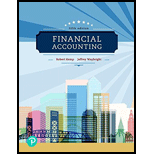
1.
Ascertain the balance of Cash and cash equivalents of Incorporation DS as of January 28, 2017 and January 30, 2016. State whether the balance has gone up or down.
2.
Explain the reasons behind the amount of cash and the changes in the cash during the year from Footnote 1.
3.
Ascertain the amount of
4.
State the facts regarding accounts receivable that is being revealed by the Footnote 1 of Incorporation DS in its annual report.
5.
Compute
6.
Compute accounts receivable turnover rate and receivable collection period for 2016. Explain what the ratios indicate about the management of liquidity.
7.
Evaluate the performance of Incorporation DS through requirement 1 to 6. Explain the management of cash and receivables of Incorporation DS.
Want to see the full answer?
Check out a sample textbook solution
Chapter 7 Solutions
Pearson eText for Financial Accounting -- Instant Access (Pearson+)
- dont use aiIf image is blurr then please comment below i will write values. if you answer with incorrect values i will give unhelpful confirm.arrow_forwardCalculate the gross profit margin on these smartphones ?arrow_forwardKindly help me with this General accounting questions not use chart gpt please fast given solutionarrow_forward
- nonearrow_forwardKelly Textiles estimated manufacturing overhead for the year to be $315,600. At the end of the year, the actual direct labor hours worked were 27,600 hours. The actual manufacturing overhead incurred was $310,800, and overhead was overapplied by $12,000. If the predetermined overhead rate is based on direct labor hours, then the estimated direct labor hours at the beginning of the year used in calculating the predetermined overhead rate must have been___. a. 27,600 direct labor-hours b. 26,800 direct labor-hours c. 27,000 direct labor-hours d. 28,000 direct labor-hoursarrow_forwardAccounting questionsarrow_forward
 Cornerstones of Financial AccountingAccountingISBN:9781337690881Author:Jay Rich, Jeff JonesPublisher:Cengage Learning
Cornerstones of Financial AccountingAccountingISBN:9781337690881Author:Jay Rich, Jeff JonesPublisher:Cengage Learning Intermediate Accounting: Reporting And AnalysisAccountingISBN:9781337788281Author:James M. Wahlen, Jefferson P. Jones, Donald PagachPublisher:Cengage Learning
Intermediate Accounting: Reporting And AnalysisAccountingISBN:9781337788281Author:James M. Wahlen, Jefferson P. Jones, Donald PagachPublisher:Cengage Learning Managerial AccountingAccountingISBN:9781337912020Author:Carl Warren, Ph.d. Cma William B. TaylerPublisher:South-Western College Pub
Managerial AccountingAccountingISBN:9781337912020Author:Carl Warren, Ph.d. Cma William B. TaylerPublisher:South-Western College Pub Financial And Managerial AccountingAccountingISBN:9781337902663Author:WARREN, Carl S.Publisher:Cengage Learning,
Financial And Managerial AccountingAccountingISBN:9781337902663Author:WARREN, Carl S.Publisher:Cengage Learning, Financial Accounting: The Impact on Decision Make...AccountingISBN:9781305654174Author:Gary A. Porter, Curtis L. NortonPublisher:Cengage Learning
Financial Accounting: The Impact on Decision Make...AccountingISBN:9781305654174Author:Gary A. Porter, Curtis L. NortonPublisher:Cengage Learning




